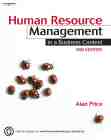
Human Resource Management in a Business Context, 3rd edition
by Alan Price
Human Resource Management in a Business Context provides an international focus on the theory and practice
of people management. A thorough and comprehensive overview of all the key aspects of HRM, including articles from HRM Guide and other sources,
key concepts, review questions and case studies for discussion and analysis.
More information and prices from:
- British pounds
- US dollars
- Australian Dollars
- Canadian dollars
- Euros
- Euros
|
Equality of Opportunity
Chapter 16 of Human Resource Management in a Business Context (2nd Edition) by Alan Price - published by Thomson Learning
Contents
Objectives
The purpose of this chapter is to:
- Define and distinguish between the concepts of equal opportunity and the management of diversity.
- Assess the scope and effectiveness of legislation and other anti-discriminatory initiatives.
- Identify the significant barriers to equality and diversity in employing organizations.
- Outline the nature and extent of discrimination on the basis of sex and gender
The meaning of diversity (includes summary of US legislation)
Society and opportunity
New Zealand
Australia
United Kingdom
Ireland (Republic)
Canada
South Africa
The emphasis of anti-discrimination legislation
Diversity and the organization
Strategies for diversity
Gender and sexual discrimination
Gender differences
Sexual harassment
Summary
Equality of opportunity is both a matter of social justice and sound economic sense.
Voluntary approaches to minimize discrimination have been largely ineffective and most
developed countries have introduced some form of anti-discrimination legislation. There
has been a tendency towards all-embracing laws in recent years, increasingly linked to
human rights legislation. Granting opportunity is beneficial to organizational
effectiveness as well as personal success. The strategic management of diversity leads
to a wider range of ideas and abilities, offering greater scope for innovation and
competitive performance in the future.
Further reading
Anti-discriminatory Practice, 3rd edition by Neil Thompson (published by
Palgrave Macmillan, 2001) provides a comprehensive review of the topic. The Diversity
Training Handbook by Phil Clements and John Jones ( published by Kogan Page, 2002)
is another practical book as is Dynamics of Managing Diversity by Gill Kirton and
Anne-Marie Greene (published by Butterworth-Heinemann, 2000). Discrimination Law Handbook
by Camilla Palmer, Gay Moon, Tess Gill, Karon Monaghan, and Mary Stacey (published by the
Legal Action Group, 2002) is a comprehensive, practical and accessible guide to
anti-discrimination law. Written by experts, it tells readers all they need to know
about UK, European and human rights laws. Global Diversity at Work: Winning the War
for Talent, 2nd edition by Trevor Wilson, (John Wiley & Son, 2002) provides a
practical Canadian perspective. The Affirmative Action Debate, 2nd edition,
edited by Steven M. Cahn (published by Routledge 2002) is a collection of articles
about the range of arguments surrounding contemporary discussion of affirmative
action. Discrimination, Jobs and Politics: The Struggle for Equal Employment
Opportunity in the United States Since the New Deal, by Paul Burstein (University
of Chicago Press, 1998) provides an interesting historical perspective. Justice in
the Workplace: From Theory to Practice (Applied Psychology Series) edited by Russell
Cropanzano (Lawrence Erlbaum Associates, 2000) and Durable Inequality by Charles
Tilly (University of California Press, 1999) take a deeper approach to the study of
persistent social inequality. Breaking Through the Glass Ceiling by Linda Wirth
(published by the International Labour Office, 2001) is a revised account of her study
on the status of women's employment in a number of countries.
Review questions
Problem for discussion and analysis - Frank and Margaret
>
>
|
|
 Human Resources
Human Resources

 Human Resources
Human Resources

